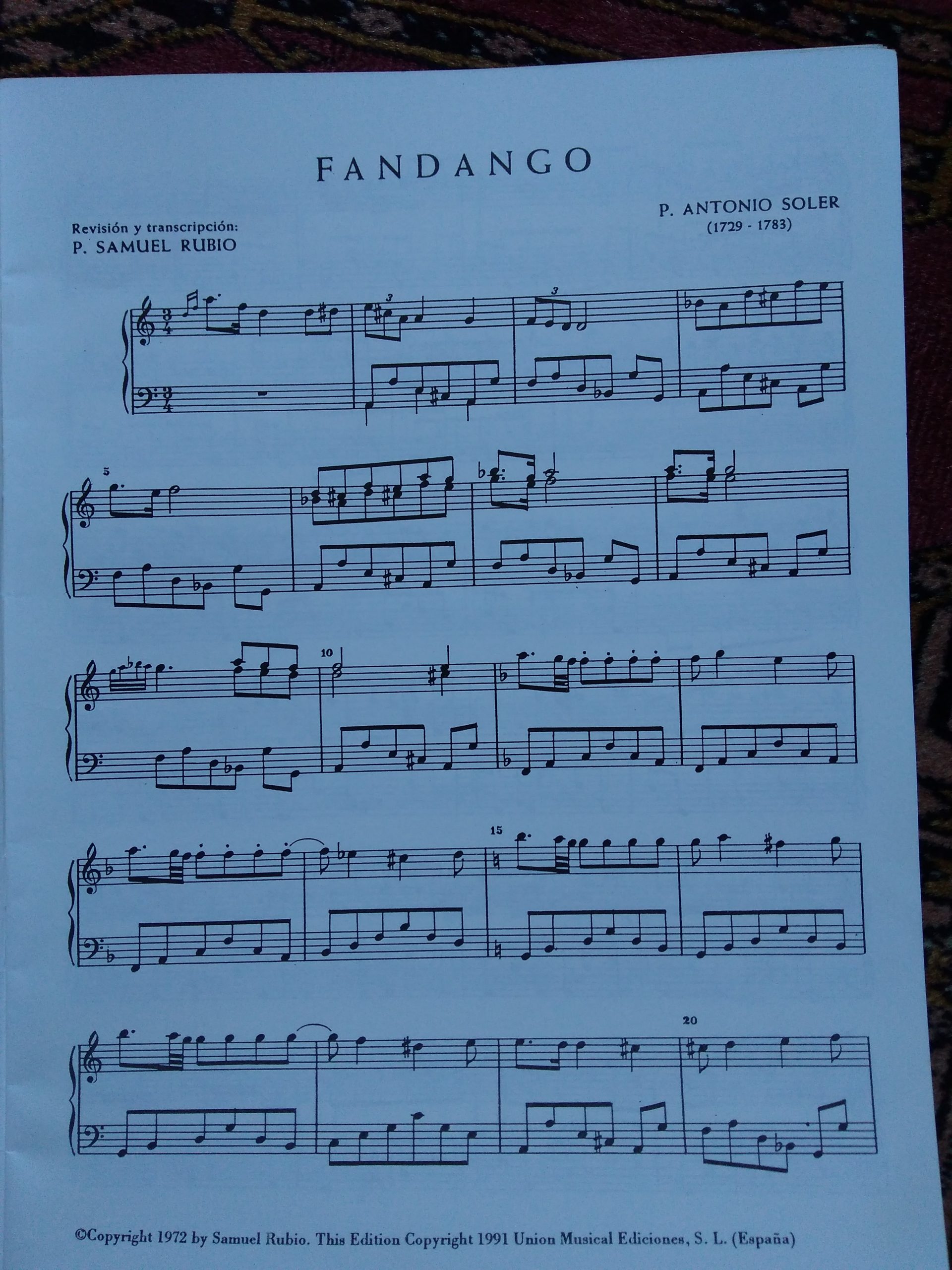 Here’s a curious piece from the late Baroque, composed by an 18th century Spanish priest who was a contemporary of Scarlatti. Padre Antonio Soler began studying music at his local monastery when he was only six, and by 14 had his first appointment as a cathedral organist. He was a prolific composer of keyboard music, thought by some to have a style more varied than Scarlatti’s, but most of his music has fallen into neglect.
Here’s a curious piece from the late Baroque, composed by an 18th century Spanish priest who was a contemporary of Scarlatti. Padre Antonio Soler began studying music at his local monastery when he was only six, and by 14 had his first appointment as a cathedral organist. He was a prolific composer of keyboard music, thought by some to have a style more varied than Scarlatti’s, but most of his music has fallen into neglect.
The piece that most often pops up today is a fascinating Fandango. It’s based on a two-bar bass pattern in implacable quavers which goes back and forth between chords of A major and G minor. With daring simplicity, Soler keeps this pattern going almost all the way through, diverting only now and then to a short episode in a different key. Over the bass pattern he devises ingenious leaps and bounds for the right hand, eventually involving both hands in complicated cross-patterns. The music is stately, but with overtones of hysteria.
The length of the Fandango is its most surprising feature; it takes about 12 minutes to play (ie about 10 minutes longer than you might expect). In a way, it seems like a Baroque forerunner of minimalism.
You constantly wonder whether Soler intended it to seem a very long piece, or whether he just got immersed and didn’t notice how many pages he had written. In a way it feels like a sort of meditation exercise, in which you focus on a word or thought to the exclusion of all else. In another way it feels like a challenge to the player: can you hold the audience’s attention for as long as it takes? You can almost imagine Padre Soler chuckling as he laid down his pen after bar 463.
But mainly it feels like the work of someone who had no interest in what listeners might think of it. It’s meant for the player; it’s something which absorbs you as you’re doing it. You can feel the long Spanish afternoon stretching ahead. How pleasant to have a cool dark room and a nice long piece to play on the harpsichord!
I once played the Fandango in a solo recital. For the first few pages, I felt the audience’s fascination. Then I started to feel that they were getting a bit restless. Then they got intrigued by how long it was, and how odd it was that it was so long. Was I still noodling around on those same two chords? It felt less like a musical experience and more like a bit of performance art. But perhaps it was never intended to be paraded in front of an audience like that.




Would like to hear it some time!
Very atmospheric, Susan, I can imagine the scene: a long, hot afternoon and a complex fandango to help pass the time. Maybe the cook or the maids could come in and do some impromptu dancing!
I’ve also been doing a bit of sight reading for fun. It is mostly very enjoyable but I’ve been annoyed on more than one occasion when the editor of a piece has thought it would be helpful to ‘remind’ me that a note has to be flat (although it’s already obvious from the key signature) or that an accidental note from a previous bar no longer applies. My brain is never fast enough, it just sees a little black mark and assumes that it must be another accidental resulting in some horrible harmonies. I wouldn’t mind if the mistake was mine but I find it annoying when the editor assumes that I don’t know the basic rules of harmony. Some rhythms are written incorrectly too – a minim note in the middle of a 4/4 bar? – which makes it difficult to count properly.
I wouldn’t mind if the music was beginner level but in something like a late-Romantic symphonic transcription such errors seem out of place.
I agree, there are some strange editorial decisions when it comes to making accidentals clear. Sometimes I appreciate being reminded that a note isn’t flat or sharp any more, but at other times I think ‘For goodness’ sake, I know that!’
Wrong rhythms …. yes, I’ve been encountering quite a few little errors in my trawl through neglected music these last few months. The better editions have clearly been checked in detail … others, not so much.
I love the Fandango, so thanks for writing about it. I have a favourite recording by Rafael Puyana; I don’t know that much about him but he really lets rip on this piece on what sounds like the biggest harpsichord you ever saw… Long? I feel quite lost when it finishes. I’m pretty sure the same recording is on youtube at https://www.youtube.com/watch?v=1TflCoyv5ao
Sorry, wrong link: that’s him playing a normal-sized harpsichord… here’s my favourite: https://www.youtube.com/watch?v=g20mDZy7-Bs